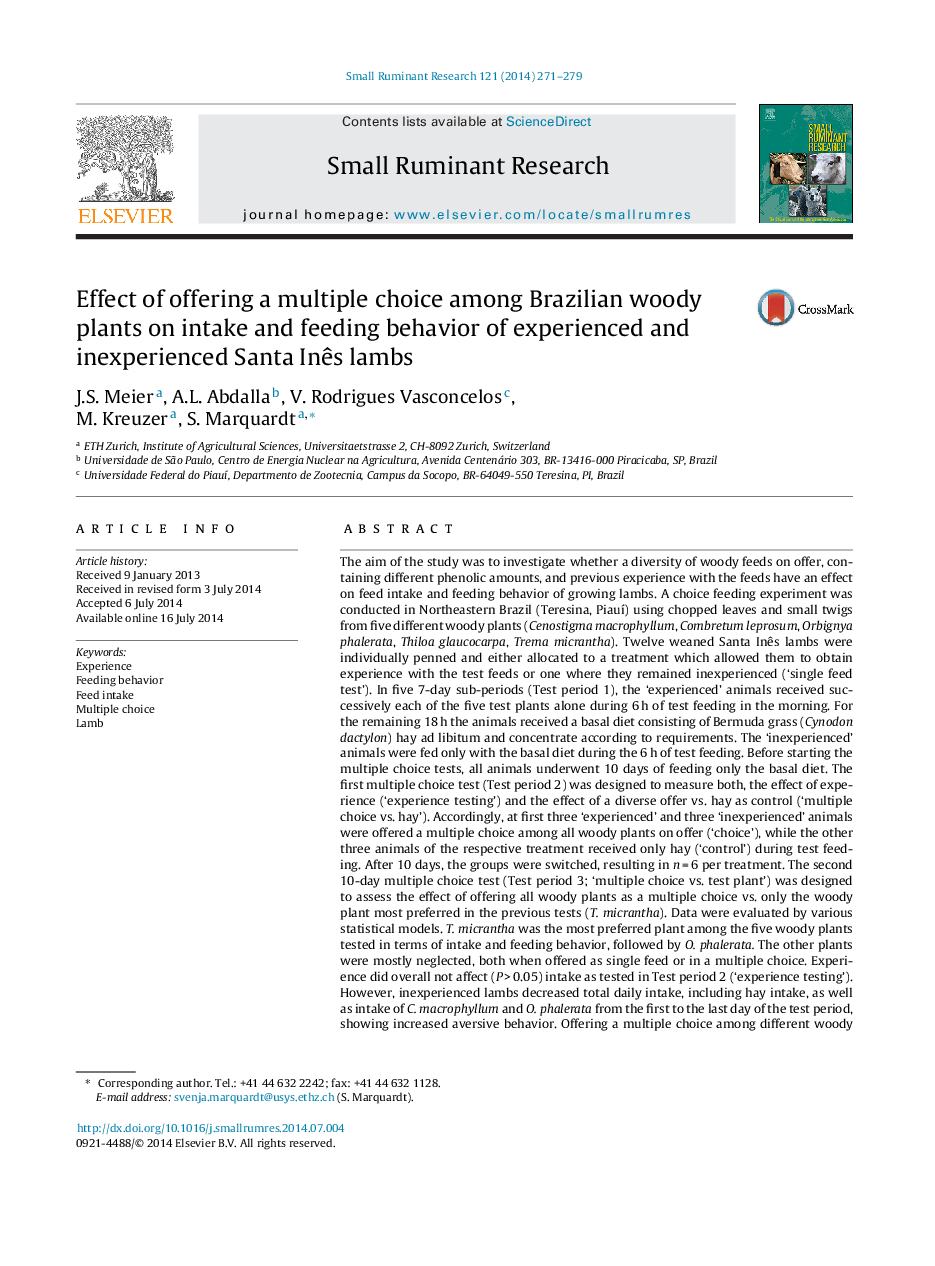| Article ID | Journal | Published Year | Pages | File Type |
|---|---|---|---|---|
| 5795556 | Small Ruminant Research | 2014 | 9 Pages |
â¢Previous experience with woody plants overall did not affect intake in lambs.â¢Previous experience caused only minor differences in choice of woody plants.â¢Multiple choice of woody plants vs. hay alone increased total daily intake.â¢Multiple choice vs. Trema micrantha alone did not increase total daily intake.â¢Feeding time and number of visits followed individual plant intake.
The aim of the study was to investigate whether a diversity of woody feeds on offer, containing different phenolic amounts, and previous experience with the feeds have an effect on feed intake and feeding behavior of growing lambs. A choice feeding experiment was conducted in Northeastern Brazil (Teresina, PiauÃ) using chopped leaves and small twigs from five different woody plants (Cenostigma macrophyllum, Combretum leprosum, Orbignya phalerata, Thiloa glaucocarpa, Trema micrantha). Twelve weaned Santa Inês lambs were individually penned and either allocated to a treatment which allowed them to obtain experience with the test feeds or one where they remained inexperienced ('single feed test'). In five 7-day sub-periods (Test period 1), the 'experienced' animals received successively each of the five test plants alone during 6 h of test feeding in the morning. For the remaining 18 h the animals received a basal diet consisting of Bermuda grass (Cynodon dactylon) hay ad libitum and concentrate according to requirements. The 'inexperienced' animals were fed only with the basal diet during the 6 h of test feeding. Before starting the multiple choice tests, all animals underwent 10 days of feeding only the basal diet. The first multiple choice test (Test period 2) was designed to measure both, the effect of experience ('experience testing') and the effect of a diverse offer vs. hay as control ('multiple choice vs. hay'). Accordingly, at first three 'experienced' and three 'inexperienced' animals were offered a multiple choice among all woody plants on offer ('choice'), while the other three animals of the respective treatment received only hay ('control') during test feeding. After 10 days, the groups were switched, resulting in n = 6 per treatment. The second 10-day multiple choice test (Test period 3; 'multiple choice vs. test plant') was designed to assess the effect of offering all woody plants as a multiple choice vs. only the woody plant most preferred in the previous tests (T. micrantha). Data were evaluated by various statistical models. T. micrantha was the most preferred plant among the five woody plants tested in terms of intake and feeding behavior, followed by O. phalerata. The other plants were mostly neglected, both when offered as single feed or in a multiple choice. Experience did overall not affect (P > 0.05) intake as tested in Test period 2 ('experience testing'). However, inexperienced lambs decreased total daily intake, including hay intake, as well as intake of C. macrophyllum and O. phalerata from the first to the last day of the test period, showing increased aversive behavior. Offering a multiple choice among different woody forages during 6 h/day ('choice') compared to only hay ('control') increased total daily forage intake from 27.3 to 32.1 g/kg body weight (P < 0.001). It was concluded that the 'control' group tried to diversify their diet when having a multiple choice option. However, when T. micrantha was offered as 'control' feed compared to a 'choice' group receiving all five test plants during 6 h test feeding, these differences disappeared. This might be mainly due to almost neglecting all other plants on offer apart from T. micrantha in the 'choice' group, leading to a similar diet of both groups.
